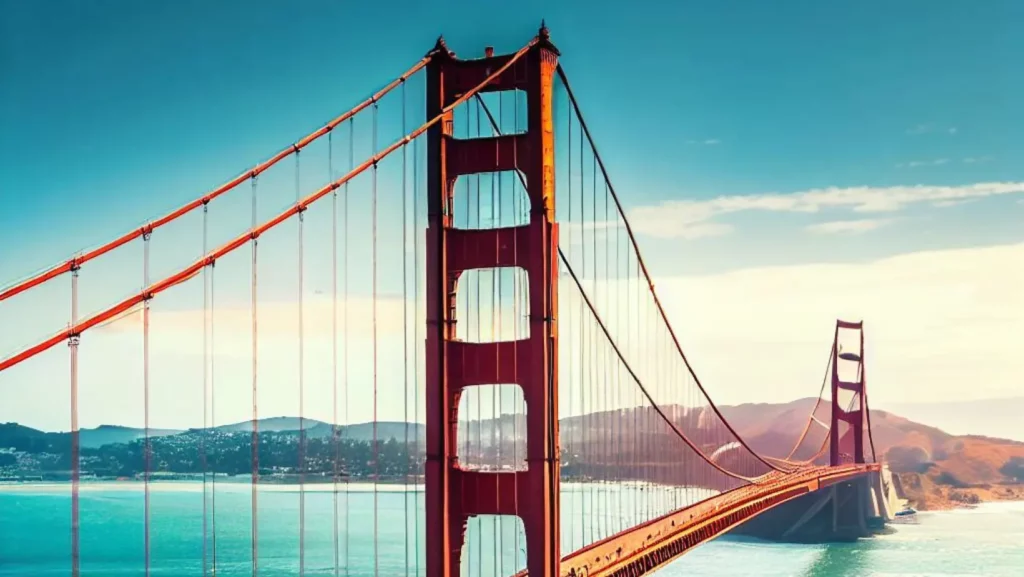Introduction
The Golden Gate Bridge is one of the most iconic landmarks in the world. Spanning the Golden Gate, the one-mile-wide (1.6 km) strait connecting San Francisco Bay and the Pacific Ocean, the bridge is a marvel of engineering and a symbol of hope and renewal.
The bridge’s history is a long and fascinating one. The idea of a bridge spanning the Golden Gate was first proposed in the 1860s, but it wasn’t until the early 20th century that serious planning began. In 1933, construction finally began on the bridge, and it was opened to traffic just four years later.
The Golden Gate Bridge was an engineering marvel at the time of its completion. It was the longest suspension bridge in the world, and it was built using some of the most advanced construction techniques of the day. The bridge’s towers are 746 feet (227 m) tall, and its main span is 4,200 feet (1,280 m). The bridge is painted International Orange, which was chosen because it was thought to be the most visible color against the fog that often shrouds the Golden Gate.
The Golden Gate Bridge: A Symbol of Hope and Renewal
The Golden Gate Bridge has come to symbolize hope and renewal for many people. It was built during the Great Depression, when hope was in short supply. The bridge’s completion was a symbol of the nation’s resilience and determination.
The bridge has also been a symbol of hope for people who have lost loved ones to suicide. The bridge is a popular spot for suicides, and the Golden Gate Bridge Suicide Prevention Marin has worked tirelessly to prevent suicides on the bridge. In recent years, the number of suicides on the bridge has declined, thanks in part to the work of the Golden Gate Bridge Suicide Prevention Marin.
The Golden Gate Bridge Today
The Golden Gate Bridge is still a marvel of engineering and a symbol of hope and renewal. It is one of the most popular tourist destinations in the world, and it is estimated that over 10 million people visit the bridge each year. The bridge is also a popular spot for photographers, and it has been featured in countless movies and television shows.
The Golden Gate Bridge is a national treasure, and it is a reminder of the power of hope and determination. The bridge is a testament to the human spirit, and it is a symbol of what can be accomplished when people work together.
Conclusion
The Golden Gate Bridge is a bridge that spans not only the Golden Gate, but also time and culture. It is a symbol of hope and renewal for people all over the world. The bridge is a testament to the human spirit, and it is a reminder that anything is possible when people work together.
Are you looking for a travel destination that combines engineering marvel with scenic beauty?
Then you should visit the Golden Gate Bridge in San Francisco, California, USA. This iconic suspension bridge spans 1.7 miles across the Golden Gate Strait, connecting San Francisco Bay with the Pacific Ocean.
It is one of the most photographed landmarks in the world, offering stunning views of the city skyline, the bay, and the ocean. Whether you want to drive, bike, or walk across the bridge, you will experience a thrill like no other.
Don’t miss this opportunity to see one of the wonders of the modern world. Book your trip to San Francisco today and visit the Golden Gate Bridge!
When was the Golden Gate Bridge constructed?
The construction of the Golden Gate Bridge began on January 5, 1933, and it was completed and opened to the public on May 27, 1937.
What is the length of the Golden Gate Bridge?
The total length of the Golden Gate Bridge, including approaches, is approximately 1.7 miles (2.7 kilometers).
What makes the Golden Gate Bridge an iconic landmark?
The Golden Gate Bridge is considered an iconic landmark due to its unique Art Deco design, vibrant orange-red color, and its significance as a crucial transportation link connecting San Francisco and Marin County.
How did the Golden Gate Bridge get its name?
The Golden Gate Bridge was named after the Golden Gate Strait, the entrance to the San Francisco Bay from the Pacific Ocean. The strait got its name from the “Golden Gate,” a term coined by John C. Frémont in 1846, signifying the entrance’s natural beauty and significance.
What is the color of the Golden Gate Bridge?
The Golden Gate Bridge is painted in an orange-red color officially known as “International Orange.” This color was chosen to enhance visibility in San Francisco’s frequent fog and has become one of the bridge’s iconic features.
How many lanes does the Golden Gate Bridge have?
The Golden Gate Bridge has a total of six lanes, with three lanes in each direction, accommodating vehicular traffic between San Francisco and Marin County.
Can pedestrians walk across the Golden Gate Bridge?
Yes, pedestrians are allowed to walk across the Golden Gate Bridge on designated sidewalks. It offers stunning views of San Francisco, Alcatraz Island, and the Marin Headlands, making it a popular destination for tourists and locals alike.
What engineering challenges were faced during the bridge’s construction?
The Golden Gate Bridge’s construction faced challenges like strong tidal currents, dense fog, high winds, and the depth of the water in the Golden Gate Strait. Engineers implemented innovative techniques and safety measures to overcome these obstacles and create the magnificent suspension bridge we see today.
What are some popular viewpoints to see the Golden Gate Bridge?
Some popular viewpoints to see the Golden Gate Bridge include Battery Spencer, Fort Point, Baker Beach, and the Marin Headlands. These locations offer picturesque vantage points to capture stunning images of the bridge against the San Francisco skyline.
How does the Golden Gate Bridge withstand earthquakes?
The Golden Gate Bridge is designed to withstand earthquakes through various engineering features, including its flexible suspension system and lateral bracing. The bridge’s towers and roadway are built to dissipate seismic energy, making it a resilient structure during seismic events. Additionally, ongoing seismic retrofitting and maintenance ensure its continued safety and stability.
Also Read: 85 Years of Engineering Excellence: The Golden Gate Bridge at California






